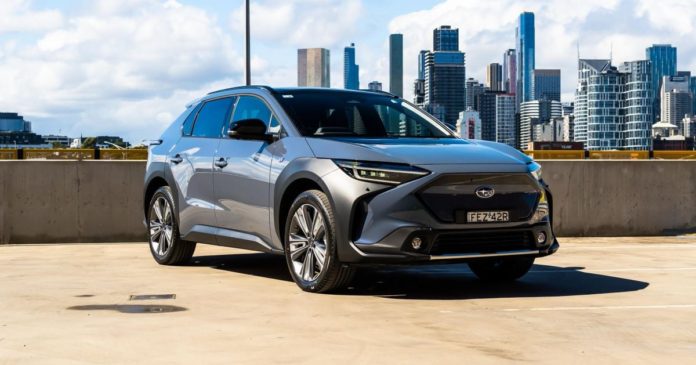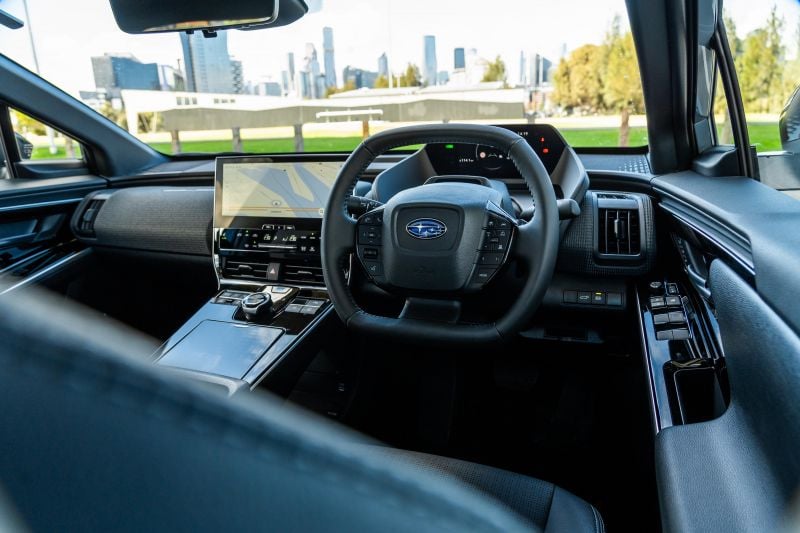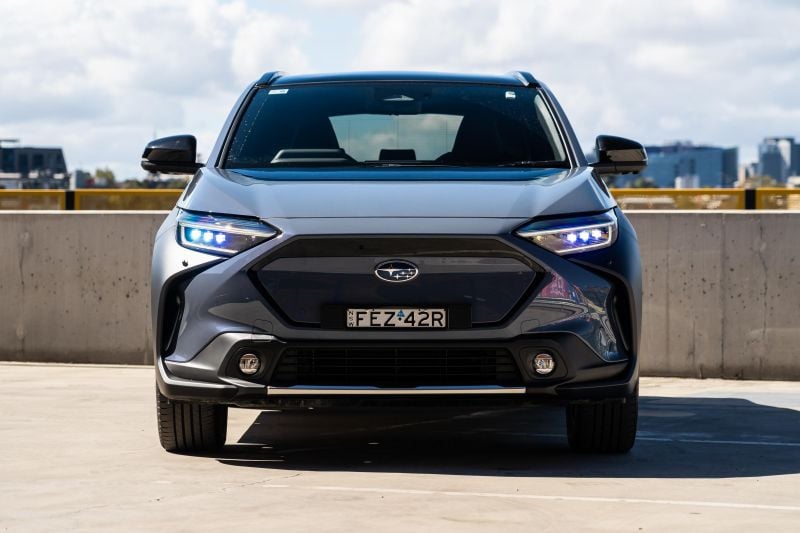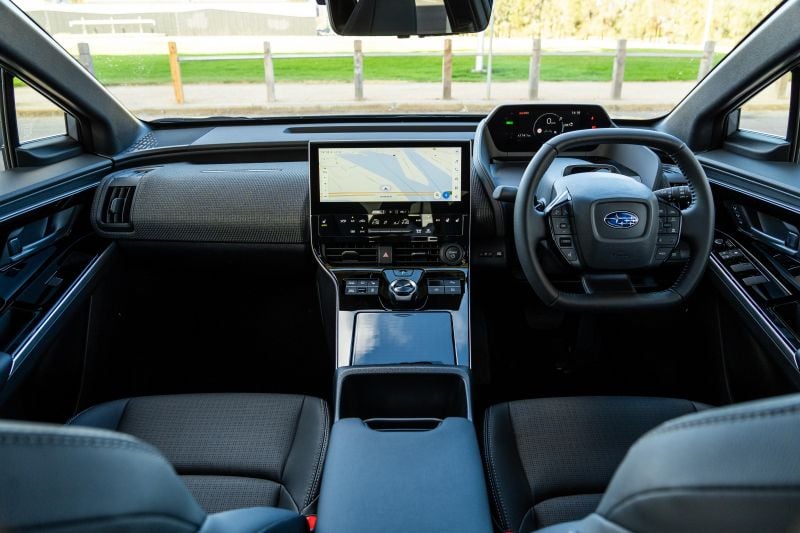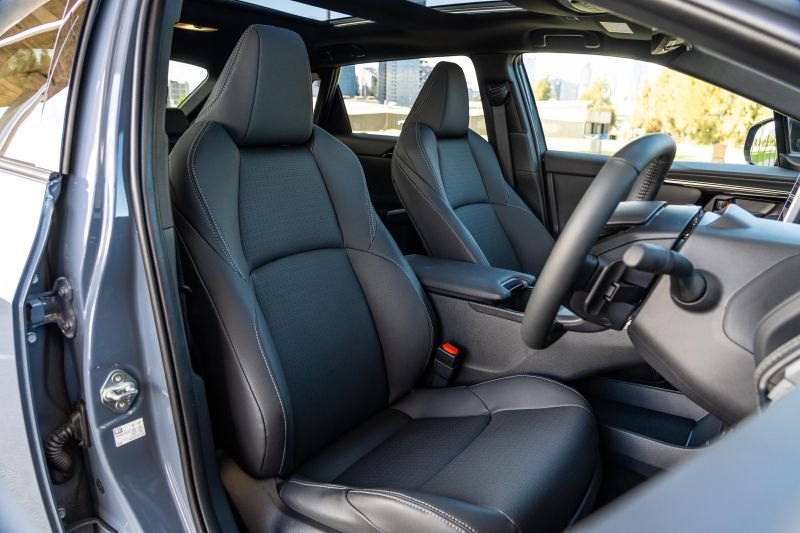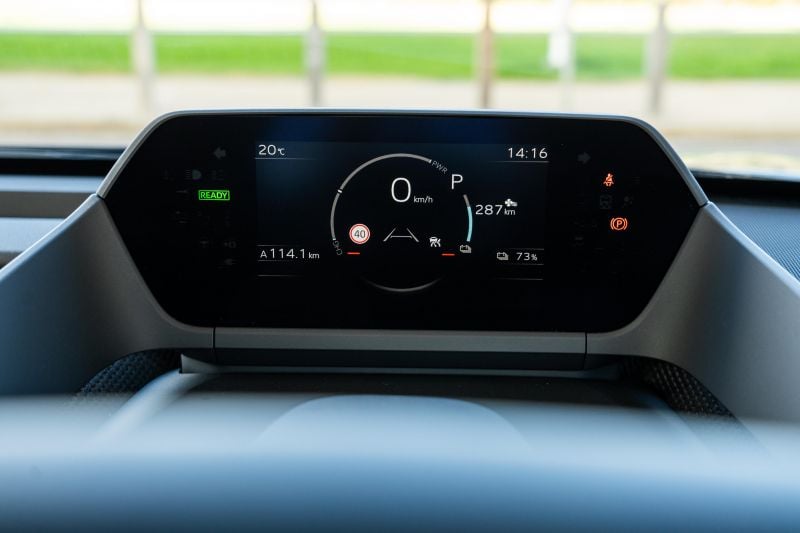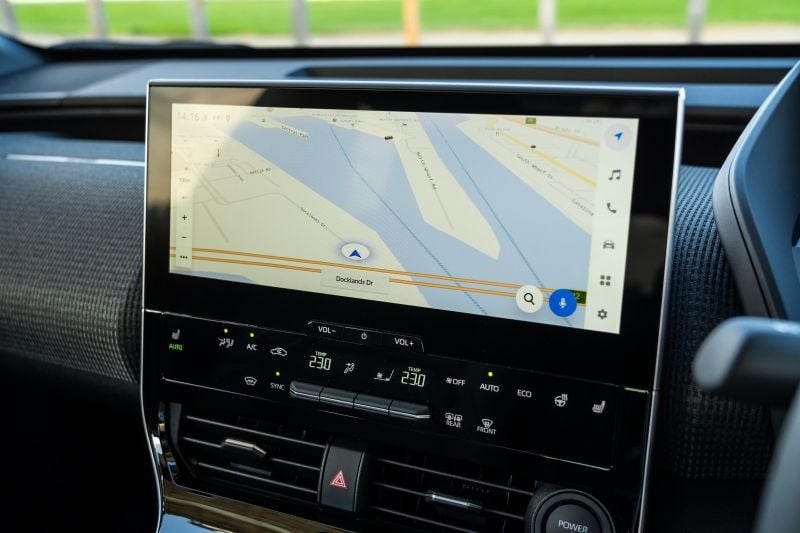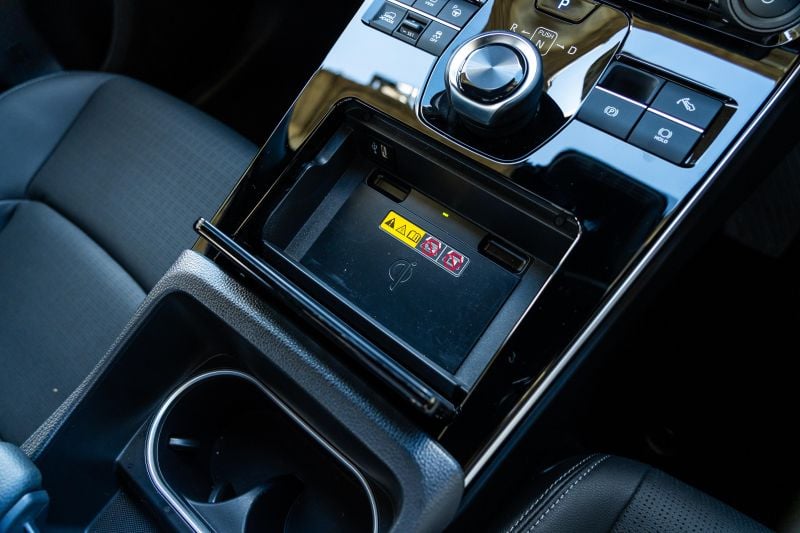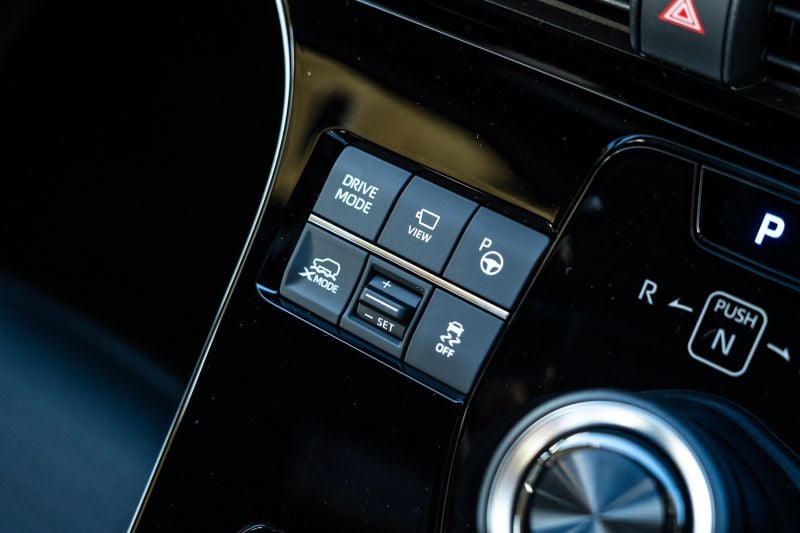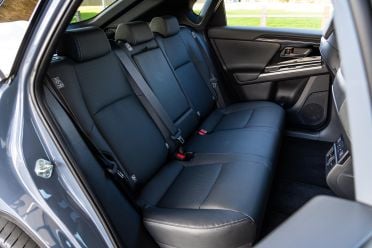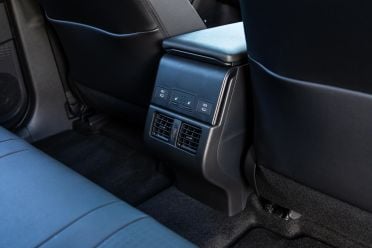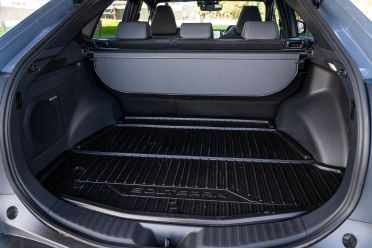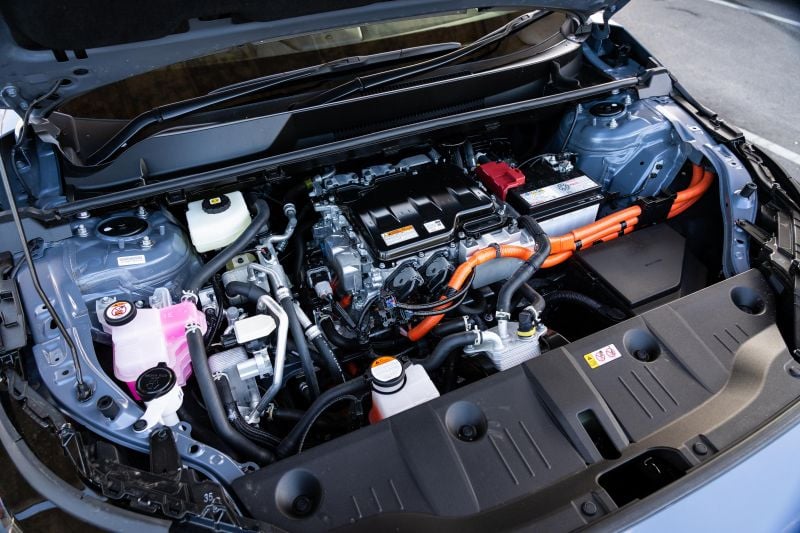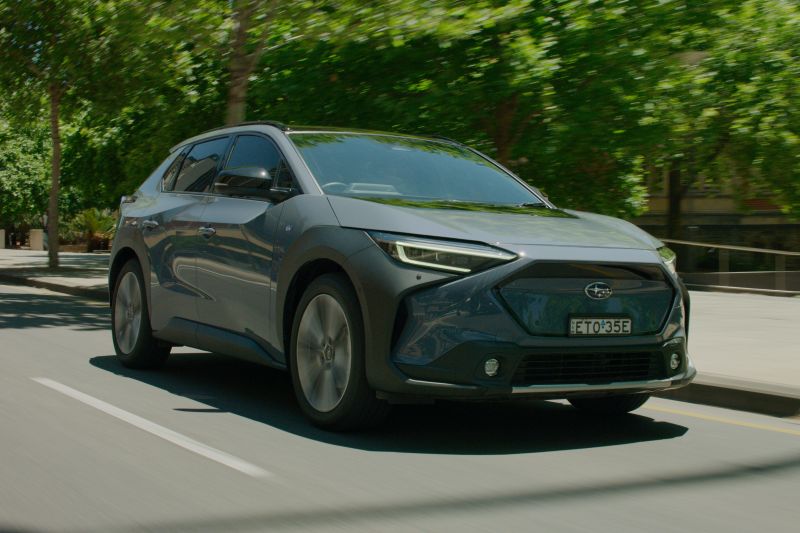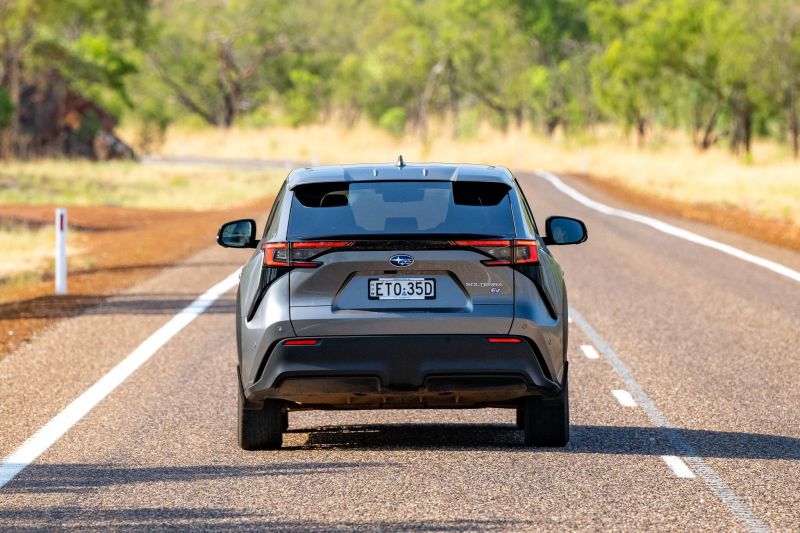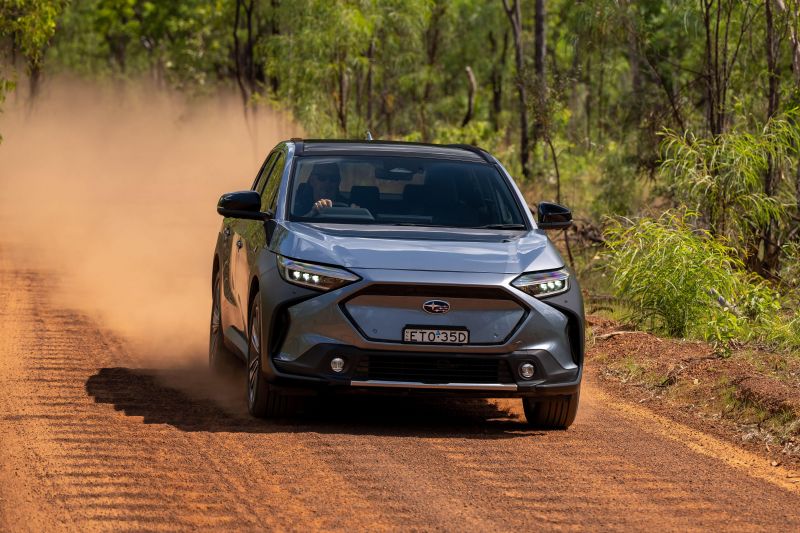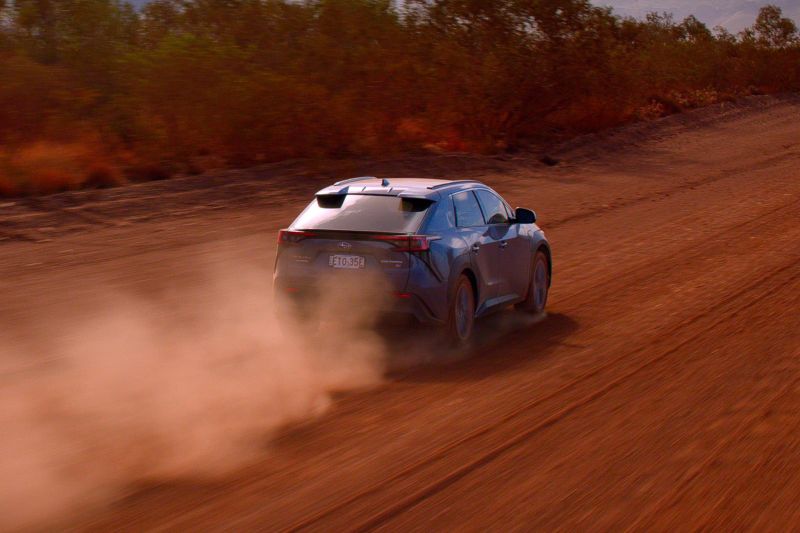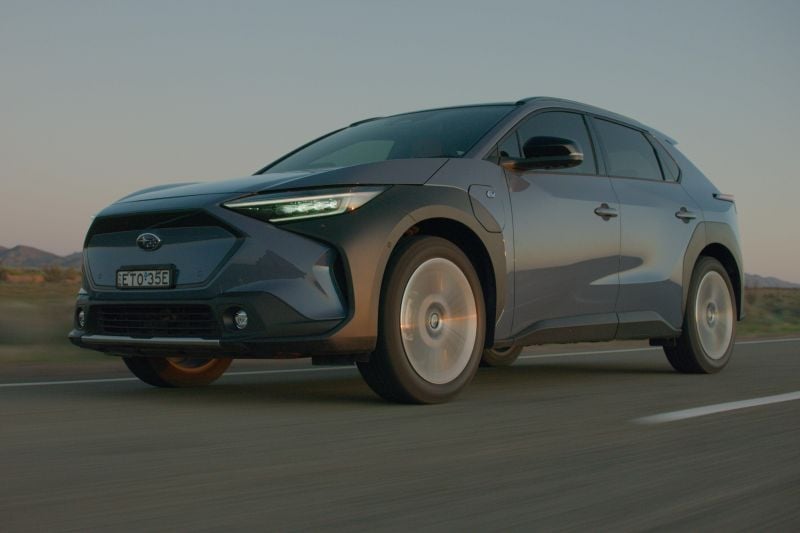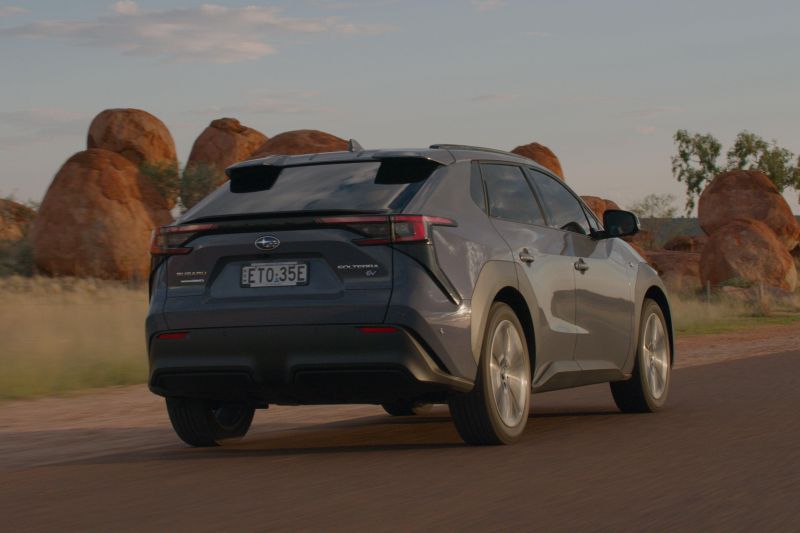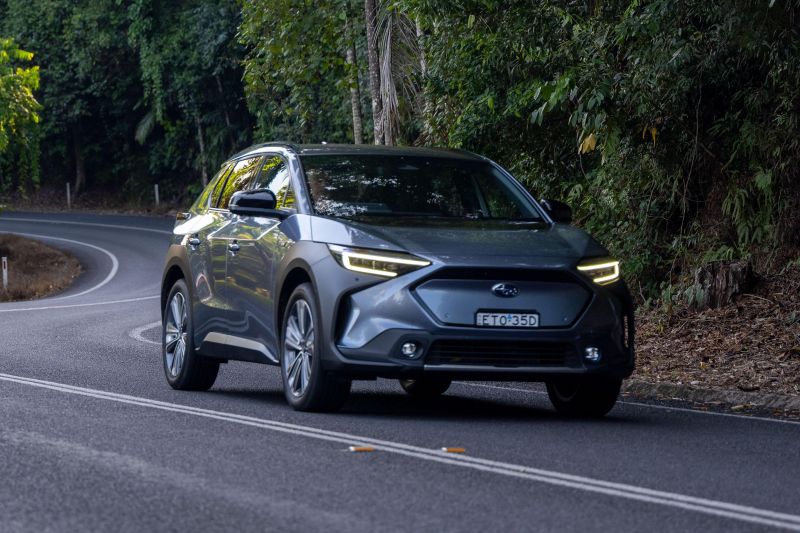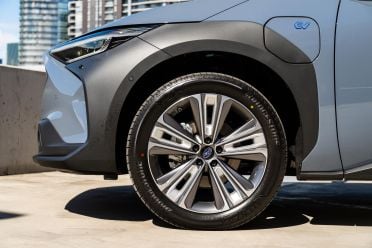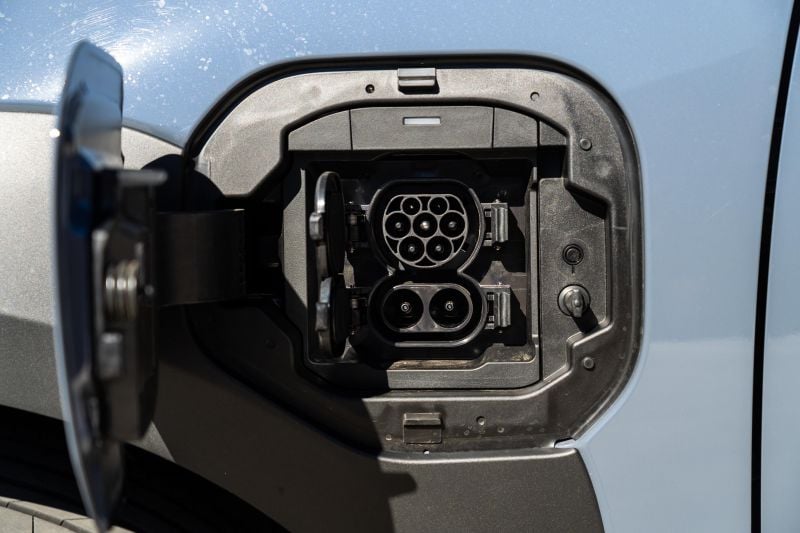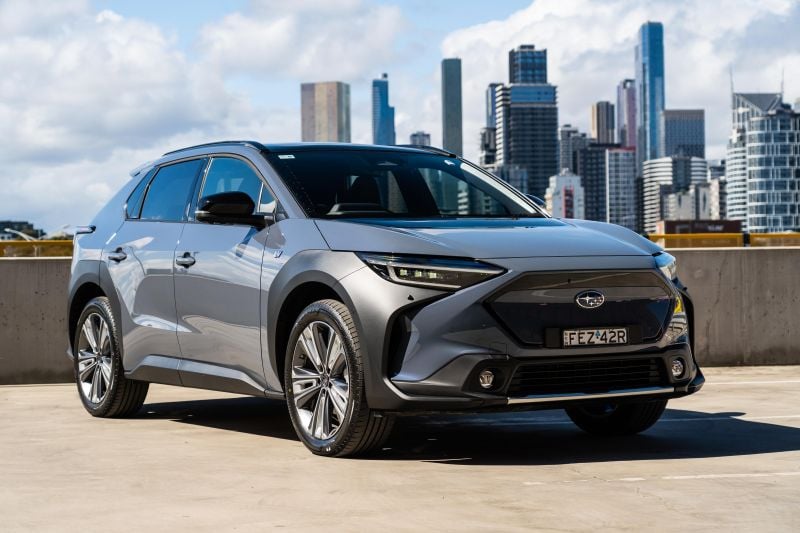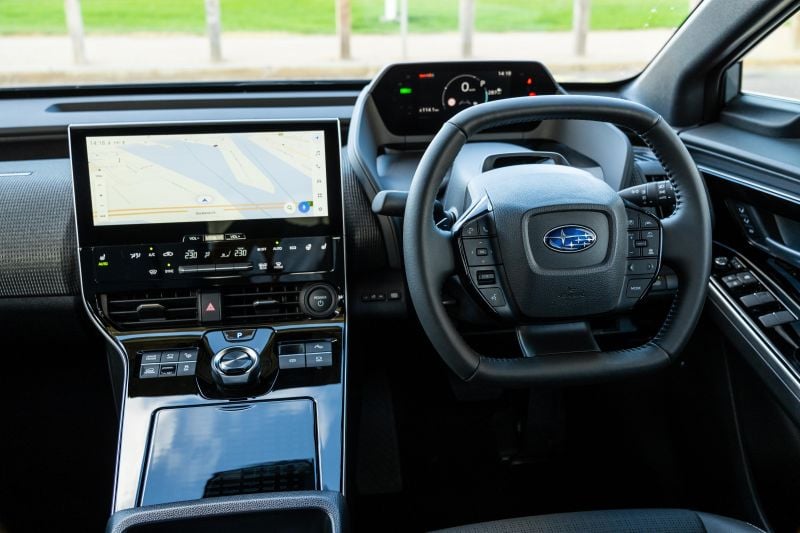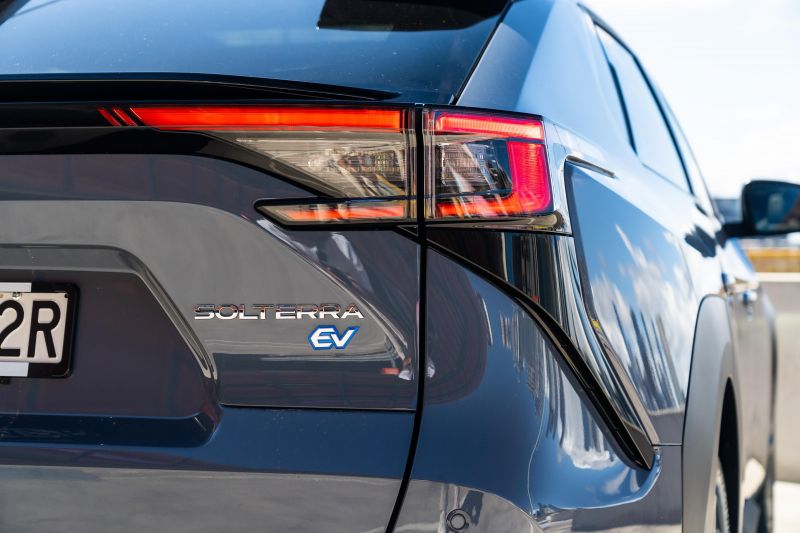Subaru’s first fully electric vehicle (EV) – the Solterra mid-size SUV – has finally launched in Australia almost two years after it launched in overseas markets like Japan and the US.
It’s arriving a little later to the competition in what is already a hotly contended segment. The most notable rival is the top-selling Tesla Model Y and it will soon have to go up against the Kia Sportage-sized EV5.
This car has been co-developed with Toyota in a similar way the BRZ/GR86 came to be. This means Toyota has its own version of this car which is calls the bZ4X – deliveries of this car also just started locally.
The Solterra and bZ4X do look almost identical though there are minor exterior and interior design differences. The former is also exclusively offered in Australia with a dual-motor all-wheel drive powertrain setup.
I’ve already reviewed the entry-level Toyota bZ4X FWD, though now I’m looking at the complete other side of the spectrum with the flagship Subaru Solterra AWD Touring.
Does this tops-sped variant form as the pick of the Solterra range? Read along to find out.
How does the Subaru Solterra compare?
View a detailed breakdown of the Subaru Solterra against similarly sized vehicles.
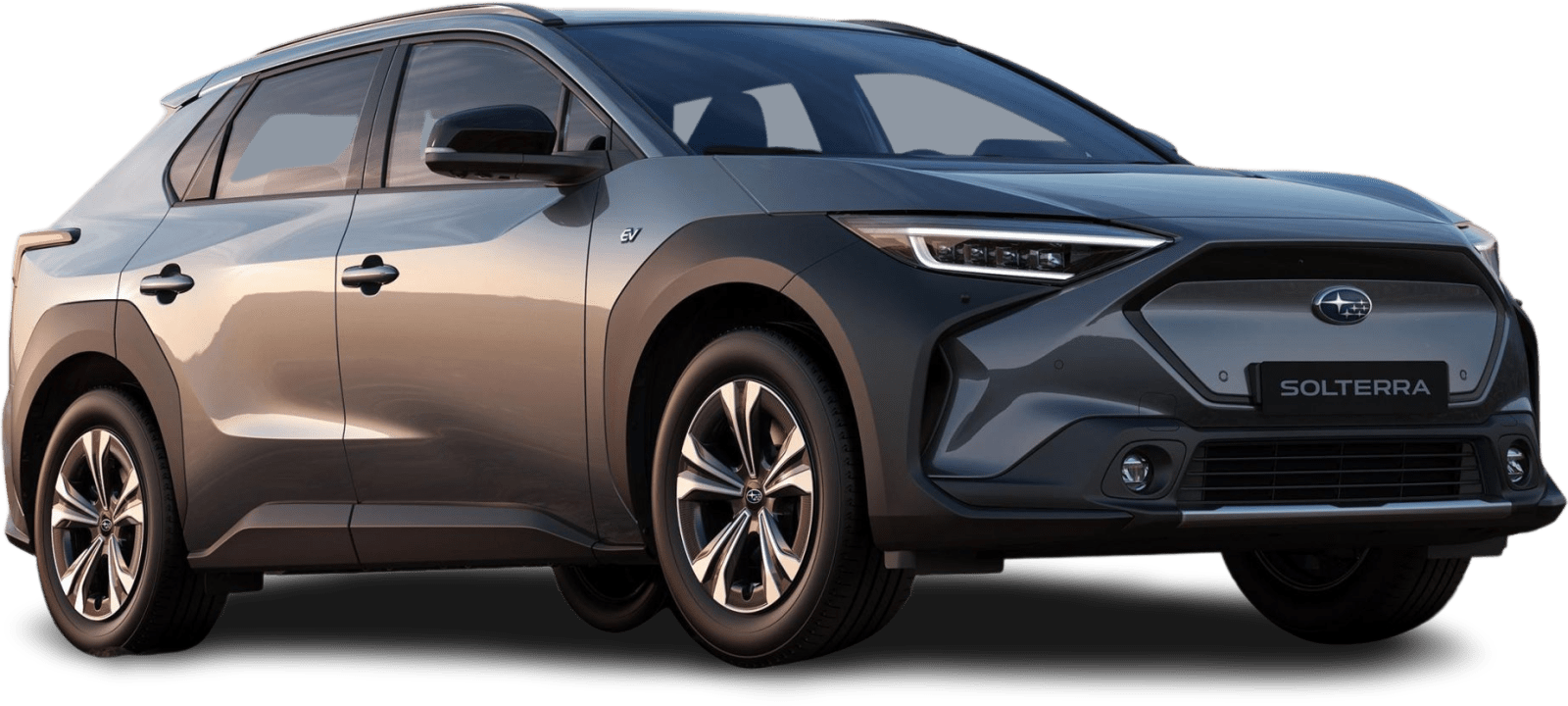
Subaru
Solterra
How much does the Subaru Solterra cost?
There are currently two Solterra variants on offer in Australia – on test here is the flagship AWD Touring variant.
2024 Subaru Solterra pricing:
- 2024 Subaru Solterra AWD: $69,990
- 2024 Subaru Solterra AWD Touring: $76,990
Prices before on-road costs
To see how the Solterra compares with its rivals, use our comparison tool.
What is the Subaru Solterra like on the inside?
Walking up to the Subaru Solterra it’s a little hard to tell it apart from the related Toyota bZ4X. One of the few distinguishing design elements is the faux hexagonal grille on the Solterra, as well as the slightly different LED headlight signature.
Thanks in part to its lifted ride height that’s inherent with crossovers, the Solterra is easy to get and out of. You can pivot in and out rather than stepping up or down, which is good for those with achy joints.
The battery pack is mounted under the floor which helps further elevate the driving position. This is something SUV buyers look for and gives you somewhat of a ‘King of the Road’ vibe.
In this flagship Solterra AWD Touring variant you get black leatherette upholstery that if you weren’t paying full attention could be confused with proper leather. It’s a little softer than actual leather however, so that’s the giveaway.
Both the front seats offer heating which is to be expected, but no ventilation. The latter could be a tad annoying as faux leather upholstery gets very hot and sticky in warm weather.
The front seats themselves are sporty-looking units that provide a really comfortable seating position. You feel supported and there’s plenty of side bolstering to secure you in.
The driver’s seat has eight ways of electric adjustment, including plenty of thigh support which is my personal favourite given I have long legs. This particular variant also picks up driver seat position memory, as well as eight ways of electric adjustment for the front passenger seat.
Ahead of the driver is a steering wheel and instrument cluster setup that looks and feels very modern and almost Peugeot-like. You need to look over the steering wheel to see the digital instrument cluster that’s mounted far away from the driver and up near the digital instrument cluster.
It’s definitely not for everyone, but in essence it has been designed to make sure your eyes don’t stray too far off the road to check your current speed, etc.
The steering wheel in the Solterra is a squared-off unit unlike the bZ4X which has a round one. It allows you to see the digital instrument cluster just a bit easier as the top is flat.
One catch of having a squared-off steering wheel however is when you go to turn the steering wheel for tighter corners. I know I grabbed where I thought the steering wheel would be but ended up grasping at thin air. You do get used to this in time, but there is a learning curve.
Thankfully the steering wheel still has plenty of push buttons and switches that are easy to understand and provide satisfying feedback.
As standard the entire Solterra range receives a 7.0-inch digital instrument cluster that’s mounted a fair distance from the driver so it looks a little small. Thankfully its interface is ultra minimal and it displays all the critical info you could every want very clearly.
There are a range of informative pages you can cycle through on the digital instrument cluster, including ones for efficiency, music, compass and settings, among others. You can also just opt to not have informative pages on display which makes the current speed info more prominent.
Moving across is a large 12.3-inch touchscreen infotainment system that sits proudly on the dashboard and feels like the centrepiece of the cabin. This touchscreen, like the digital instrument cluster, is the exact same as the bZ4X and has the Toyota interface which is easy to navigate.
The screen itself appears to be really high-resolution and is bright enough that it can be viewed in sunny situations. It’s also very responsive to touch inputs which makes opening new apps and scrolling through menus seamless.
As standard the Solterra comes with wired and wireless forms of both Apple CarPlay and Android Auto. With my iPhone 15 Pro Max connected wirelessly I didn’t experience any dropouts whatsoever, which is a little surprising.
Thankfully this car also comes with a wireless charger which is located on the centre tunnel and was able to keep my phone battery topped up nicely on longer trips.
There’s also satellite navigation as standard which is great for when your phone runs out of service and you still need to find your way home. Unlike the bZ4X it’s not connected to internet though, which means no live traffic info.
I appreciate the climate control pod is really easy to understand and operate unlike some cars which bury the functions in the touchscreen. There are some physical switches, as well as touch-sensitive buttons which got a little smudgy and fingerprint-ridden after a bit.
Looking around the cabin there are plenty of buttons. This is nice to see as the majority of the critical functions are within quick reach of the driver. It feels like a Subaru in this sense.
From a switchgear perspective the Solterra feels like the polar opposite to the Tesla Model Y which is very minimalistic and requires you to use the central touchscreen for many functions.
Despite the dark headliner the Solterra’s cabin is a pretty light and airy place to be with good visibility. It’s even brighter when you open up the shade for the panoramic glass roof. It’s a fixed unit however which means it doesn’t tilt or slide, plus there’s a thick pillar blocking the view.
The dashboard is finished in a woven fabric textile that’s fascinating to look at given it has a rough texture. It’s similar to what Mini is doing in its current models, including the new Countryman and Cooper.
Disappointingly however there’s a tonne of piano black. It’s plastered on the entire centre console and even features on the door panels which are both high touch-points. This got very dusty and grimy during our loan period, and also gets scratched really easily when you clean it.
Another oddity about the Solterra is there’s no typical glovebox on the passenger side. In order to make up for this the car has a deeper-than-usual centre console box. There’s an insert in the centre console which can be pulled out to reveal more covered storage.
The Solterra also has an open space under the piano black-ridden centre console which is large enough to accommodate a handbag or devices that are charging from the two USB-C ports or 12V socket. It’s worth noting the door bins are also large enough to house a big water bottle plus other odds and ends.
The last thing I’ll mention before talking about the second row is the Solterra AWD Touring’s 10-speaker Harman Kardon premium sound system didn’t impress me as much as I thought it would. Sure it sounds okay but it’s not as fantastic as I’d expect a Harman Kardon-branded system to be.
Moving to the second row I was surprised how much space is on offer in the Solterra. It’s a very generous space with plenty of leg, head and shoulder room.
There are a couple of catches, however. Toe room is restricted, and like a number of other EVs you feel like you have your knees up higher than usual because the battery pack raises the floor height.
Two adults fit easily in the second row of the Solterra, though trying to squeeze three is doable but only for shorter trips. Thankfully there’s a flat floor which makes fighting for foot space a bit easier.
In terms of second-row amenities there are heated outboard rear seats, centre console-mounted air vents, USB-C ports, as well as a fold-down armrest with cupholders and a phone holder. There are also the requisite ISOFIX child seat anchor points on the two outboard seats, plus top-tether points on all three rear seats.
At the back there’s a power tailgate that opens swiftly, and thankfully only beeps once to announce its intention to either open or close.
Once the tailgate is open the boot space on offer isn’t fantastic relative to other EVs. Subaru officially claims the Solterra has a boot capacity of 410 litres.
Given this car is based on a dedicated electric architecture I’m disappointed there’s barely any underfloor storage in the Solterra – it’s only really big enough for a charging cable. There’s also no frunk whatsoever.
The Solterra only comes with a tyre repair kit which isn’t surprising for an EV. It’s something to keep in mind however if you plan to venture far from tyre repair shops as you could be stuck waiting for a while for roadside assistance.
What’s under the bonnet?
The Subaru Solterra is exclusively offered locally with a dual-motor all-wheel drive powertrain. There is a single-motor option offered in the related Toyota bZ4X, as well as the Japanese-market Solterra.
| Model | Subaru Solterra AWD |
|---|---|
| Electric motor setup | Dual electric motors |
| Power | 160kW |
| Engine torque | 337Nm |
| Driven wheels | All-wheel drive |
| Battery | 71.4kWh lithium-ion |
| Range | 485km (NEDC) |
| Maximum AC charging rate | 11kW |
| Charging time (10-80 per cent) | ~6.5 hours |
| Maximum DC charging rate | 150kW |
| Charging time (0-100 per cent) | ~30 minutes |
| Weight | 2060kg (tare) |
| Energy consumption (claim) | 14.1kWh/100km (NEDC) |
| Energy consumption (observed) | 17.8kWh/100km (500km mixed driving) |
Using my observed energy consumption the Solterra AWD Touring has a real-world range claim of just over 400km.
It’s worth noting my observed energy consumption was generally higher than what I saw in the single-motor, front-wheel drive Toyota bZ4X I recently reviewed which has the exact same battery pack size.
To see how the Solterra compares with its rivals, use our comparison tool.
How does the Subaru Solterra drive?
Starting up the Solterra feels familiar to an internal combustion engine (ICE) car as it has a proper start button. The only difference is there’s no engine ignition noise when you press the button. Only a beep plays signifying the car is ready to be driven.
Setting off you need to acquaint yourself with the Prius-style puck gear selector which takes a bit to get used to. In order to select either drive or reverse you need to push the puck down and then twist either left or right, depending on which direction you intend to head.
Although the Solterra does have dual electric motors as standard, its acceleration won’t plant you back in the seat like some more performance-oriented EVs do. Instead it accelerating linearly and somewhat docilely. A single-motor Tesla Model 3 RWD beat it from the light for context.
Thankfully like all EVs the full amount of torque is available from standstill which means you can lean on the throttle at low speeds and get the jump on most cars.
Driving the Solterra also feels similar to an ICE car. There’s no one-pedal driving mode which in my personal preference is the most natural way to drive an EV. This means you need to depress the brake pedal to actually come to a stop in the Solterra.
Instead this has a standard driving mode it defaults to every time you start up car, which allows it to coast like an ICE car when you take your foot off the accelerator without any regenerative braking.
You can however use the paddle shifters behind the steering wheel to modulate the amount of regenerative braking provides. There’s also an ‘S Pedal’ function that boosts regenerative braking as much as possible which is activated by pressing a button on the centre console.
The throttle in this mode becomes more numb to accommodate the regenerative braking that’s factored into the accelerator pedal travel.
When you have the ‘S Pedal’ function turn on, which I did for the majority of my testing, the car will slow itself down at a fairly linear rate to around 5-10km/h without depressing the brake pedal whatsoever, though as I noted before you still need to press it to come to a complete stop.
I don’t believe it’s the end of the world that the Solterra doesn’t have a one-pedal driving system, as this car is intended for those transitioning out a regular ICE or hybrid car.
Something I like about Solterra is the digital instrument cluster shows when the brakes lights are illuminated. I recently tested the GWM Ora which in its one-pedal driving mode didn’t illuminate the brake lights once you came to complete stop.
It’s good and reassuring to know when your tail lights are illuminated in the Solterra so the vehicles behind you are aware you’re slowing down.
Given the Solterra comes standard with all-wheel drive this adds a bit of security when you’re driving in slippery conditions, whether that be on- or off-road.
Speaking of off-road driving, the Solterra comes with Subaru’s X-Mode terrain driving modes. There are two different modes – Snow/Dirt and Deep Snow/Mud – as well as a Grip Control function. The latter acts a bit like a low-speed cruise control.
Around town the Solterra is quiet and serene. This isn’t uncommon for EVs as there’s no engine chugging away under the bonnet. The only noticeable sound is the odd bit of tyre noise when you’re turning corners.
At low speeds the car’s suspension tune is very comfortable and settled which is to be expected give it’s branded a Subaru. The electric SUV takes speed bumps like a champ and doesn’t ever feel awkward over harsher bumps.
The Solterra’s steering is on the lighter side which makes it easy to whip. The only catch is the square steering wheel can get a little cumbersome when you need to turn the wheel a little tighter. It would be nice to have a steer-by-wire system so you didn’t have to cross your hands over when turning.
As standard the Solterra comes with front and rear parking sensors, as well as a surround-view camera which has great picture quality and also a transparent chassis mode. In addition the car comes with an auto-parking feature that’s surprisingly great.
Unlike other parking systems from other car brands, the Solterra’s doesn’t require it scan the space between two cars. Instead the systems uses the surround-view camera to slot the car between line markings.
The auto-parking system is very slow but reassuring in the way it guides the car into the park. It will even do a virtual spin around the car on the infotainment touchscreen to show how it has parked perfectly within the lines.
Building up speed in the dual-motor all-wheel drive Solterra is easy and effortless. It doesn’t feel like it’s ever really out of puff, even at highway speeds, and still has enough oomph in reserve to overtake if necessary.
There’s a bit more obvious tyre roar at higher speeds, especially on coarse-chip roads that are prolific in rural Australia, though for the most part it’s still quiet inside the cabin.
Just like at low speeds, the suspension tune is very comfortable at higher speeds, though sometimes harsher bumps are transmitted into the cabin. Continuous undulating bumps, however, are ironed out smoothly, which is satisfying.
On the safety front the Solterra is fully loaded. Thankfully every version of this car receives the full suite of available safety equipment (unlike the related bZ4X) though you do pay a price premium for the privilege.
The adaptive cruise control reacts to other cars merging into your lane very naturally. If the cars are travelling faster than the Solterra thankfully it thankfully doesn’t slam on the brakes like some.
This is considerably better than a number of other Subaru models that exclusively use a camera-based adaptive cruise control system which can be a little hit and miss.
The lane-keep assist and lane centring function which can be activated by pressing a button on the steering wheel is up there with some of the best I’ve tested so far.
When this function is activated the car will keep itself within a lane really well. It has road edge detection which means it works even without proper line markings. This is incredibly handy for those who live in rural and regional areas.
It’s not all perfect however, as like most lane centring systems it does get lost on the odd occasion. Thankfully all you need to do to fix this is slightly nudge the steering wheel back in the correct direction.
As standard the Solterra comes with bright LED headlights, though unfortunately they don’t swivel when you turn like some Subaru models. They do however, have an adaptive high-beam function which automatically dips a portion of the light when it detects a car’s headlights or tail lights.
The adaptive high-beam function is perfect for those who live in dimly-lit country areas who don’t want to faff around with dipping your lights every time you meet a car.
I found in practice though the adaptive high-beam function would sometimes be overly eager to dip portions of the high-beams and others it wouldn’t dip quickly enough, resulting in getting flashed from oncoming cars.
What do you get?
There are two trim levels on offer in Australia – on test here is the flagship Touring.
Solterra AWD highlights:
- 18-inch alloy wheels
- Tyre repair kit
- Rear privacy glass
- 2kW AC charging cable
- Power-folding exterior mirrors
- Automatic self-levelling LED headlights
- Adaptive high-beam
- Puddle lights
- Rain-sensing wipers
- Power tailgate
- Keyless entry, start
- Electronic parking brake
- Dual-zone climate control
- Tilt, telescopic steering wheel adjustment
- 12.3-inch touchscreen infotainment system
- Satellite navigation
- Wireless Apple CarPlay, Android Auto
- 7.0-inch digital cluster
- 6-speaker sound system
- DAB+ digital radio
- 2 x front USB-C outlets
- 1 x front USB-A outlet
- 2 x rear USB-C outpets
- Digital rear-view mirror
- Leather-wrapped steering wheel
- Heated steering wheel
- Cloth upholstery
- 8-way power driver’s seat
- Heated front seats
- Heated outboard rear seats
- Reclining rear bench
Solterra AWD Touring adds:
- 20-inch alloy wheels
- Auto-dipping exterior mirrors with memory
- Panoramic glass roof
- Semi-automatic parking assist
- Ambient lighting
- Leatherette upholstery
- Driver memory function
- 8-way power passenger seat
- 10-speaker Harman Kardon sound system
- Wireless phone charger
Is the Subaru Solterra safe?
The Subaru Solterra has a five-star ANCAP safety rating, based on testing conducted by Euro NCAP on the bZ4X in 2022.
-
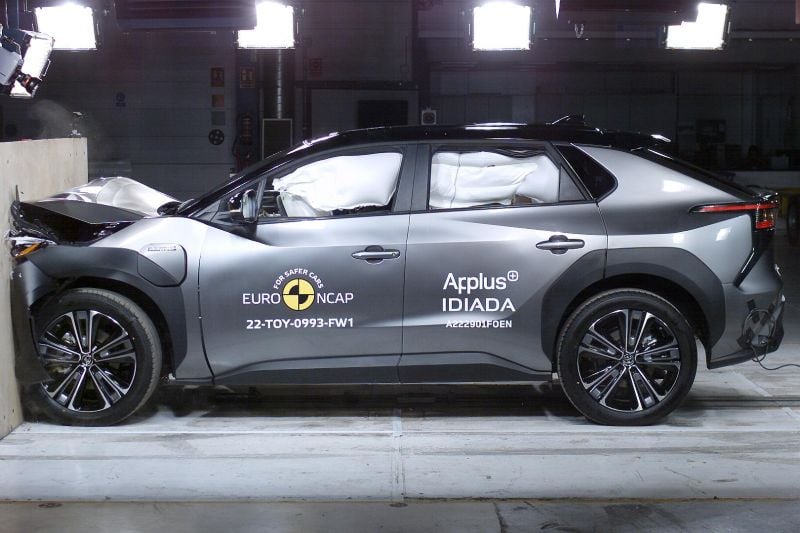
Toyota bZ4X Euro NCAP crash test
It received an adult occupant protection rating of 88 per cent, a child occupant protection rating of 88 per cent, a vulnerable road user protection rating of 79 per cent, and a safety assist rating of 93 per cent.
Standard safety equipment includes:
- Adaptive cruise control
- Autonomous emergency braking
- Blind-spot monitoring
- Driver attention monitoring
- Emergency Steering Assist
- Lane Tracing Assist (lane centring)
- Parking Support Brake
- Rear cross-traffic alert
- Safe Exit Assist
- Surround-view camera
- Traffic sign recognition
- Tyre pressure monitoring
- Front and rear parking sensors
- Front, front-side, curtain and front-centre airbags
How much does the Subaru Solterra cost to run?
The 2024 Subaru Solterra is covered by a five-year, unlimited-kilometre warranty, as well as an eight-year, 160,000km battery warranty.
Subaru is offering free servicing for the first five years or 75,000km – with intervals of 12 months or 15,000km. There’s also five years of roadside assistance.
The company is offering a choice of either an Ocular LTE single-phase 7kW Type 2 wallbox for $2250 including installation, or a three-phase 22kW unit for $2645.
CarExpert’s Take on the Subaru Solterra
The Subaru Solterra is a surprisingly good EV if you’re stepping into it from the perspective of owning an Subaru- or other legacy-branded ICE-powered car and have never driven an EV before.
Everything is where you would expect it to be and you don’t need to faff around too much with the touchscreen infotainment system to adjust functions like some EVs. It’s nice there’s no shortage of physical buttons in the Solterra.
This ICE-like experience even carries through to the way the Solterra drives. With no proper one-pedal driving mode you’re forced to use the brake pedal to come to a complete stop.
This isn’t my preferred way to drive an EV, but I can understand why people who are hopping into an EV for the first time would like some form of familiarity with the driving experience. Given the car is silent that can already be a lot to grapple with.
A catch with the Solterra however is its price…
Although it was recently slashed and still includes goodies like a complimentary five-year service plan and five years of roadside assistance among other inclusions, it still doesn’t stack up as good value when compared to the likes of the top-selling Tesla Model Y. The entire Solterra range still slides under the FBT threshold though.
The flagship Solterra AWD Touring variant on test here doesn’t form as the sweet spot of the range. Sure it’s fully loaded but I’d much rather opt for the entry-level model given it doesn’t lose too many features and gets smaller 18-inch alloy wheels which would likely bring an even better ride.
I’m also not a huge fan of the observed energy consumption I saw during my week of testing. An average of almost 18kWh per 100km in mixed city and highway driving is alright but nowhere near class-leading.
I experienced considerably better energy consumption with the single-motor Toyota bZ4X though I understand this model doesn’t come with the security of all-wheel drive and the X-Mode off-road drive modes.
Click the images for the full gallery
MORE: Buy a Subaru Solterra
MORE: Everything Subaru Solterra

